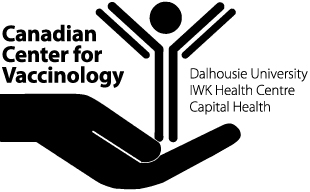Pneumococcal diseases can cause serious, sometimes life-threatening symptoms – especially in children. In Canada, vaccines protect against 13 types of the bacteria that cause these illnesses in children and 23 in adults. Learn more about what these diseases are with this infographic:
Image text and description:
(Image: Long rectangular infographic with sections in various shades of grayish blue or white, with blue or white text.)
Canadian Center for Vaccinology’s ALL ABOUT PNEUMOCOCCAL DISEASE. //
What Is Pneumococcal Disease?
Pneumococcal disease is an umbrella term for diseases caused by pneumococcus bacteria. This can include pneumonia, meningitis, inner ear infections, and more. Some pneumococcal diseases can be serious or even fatal.
(Image: An illustration of a woman with light skin and brown hair sneezing into a tissue, wearing a pink top, is to the right side of this section.)
Pneumococcal Diseases Can Include:
The body text is in bullet points and reads:
- Pneumonia
- Meningitis
- blood infection
- ear infection
- sinus infection
(Image: This section is set on a slant underneath the first, so that it appears to be an addition to the section above. )
The cause: Pneumococcus
There are over 100 types of the bacteria Streptococcus pneumoniae (pneumococcus). Some of these can cause pneumococcal disease. Some people can be carriers of the bacteria, meaning that they won’t get sick from it but can pass it on to others.
(Image: This section is accompanied by an illustration of blue and yellow dots in a cluster, representing bacteria.)
How serious is Pneumococcal Disease?
Pneumococcal diseases can range from minor symptoms to life-threatening. It is often most serious in infants, the elderly, or the immuno-compromised. It is a high cause of mortality in children under five-years-old around the world each year.*
*Source: Wahl B, et al. Burden of Streptococcus pneumoniae and Haemophilus influenzae type b disease in children in the era of conjugate vaccines: global, regional, and national estimates for 2000-15. Lancet Global Health. 2018;6(7):e744-757.
(Image: an illustration shows a man with dark brown skin and black hair in a hospital bed. A doctor or nurse is adjusting an IV bag on a pole beside the bed. They also have dark brown skin and are wearing dark blue scrubs. Both people are wearing masks).
What are the signs?
Each pneumococcal disease has different symptoms. Some examples include:
- Headache (Image: illlustration of a man holding his head, with eyes closed and squiggles representing pain radiating from his head)
- Fever or chills (Image: illustration of a under-the-tongue type thermometer with a digital read out and metal tip)
- Stiff neck (Image: Illustration of a man holding his neck in pain, with squiggles to represent pain radiating from the neck)
- Sensitivity to light (Image: illustration of a sun)
- Confusion (Image: Illustration of a woman holding her head. Spirals near her head visually represent confusion)
- Ear pain (Image: illustration of an ear)
- Cough (Image: illustration of a woman coughing into her elbow)
- Chest pain (Image: illustration of a woman with her hand on her chest in pain, a red circle emanating from the spot she is holding)
*Source: https://www.cdc.gov/pneumococcal/about/symptoms-complications.html
How is it prevented?
The main protection for pneumococcal diseases comes in the form of vaccines. Current Pneumococcal Conjugate Vaccines (PCVs) in Canada boost protection against 23 types of the bacteria in adults or 13 in children.*
*Source: https://www.canada.ca/en/public-health/services/publications/healthy-living/canadian-immunization-guide-part-4-active-vaccines/page-16-pneumococcal-vaccine.html
(Image: an illustration of two rectangular bandaids or plasters criss crossed to form an x. One is a reddish pink and one is a lighter tone of pink)





